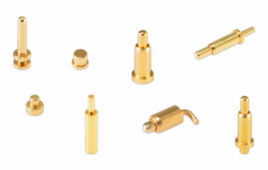To supply speed and throughput requirements, network developers primarily make tradeoffs with two parameters: cable length and topology. However, you can work with these tradeoffs to obtain the data throughput and transmission speed that you need. For example, by using one type of topology, you may be able to extend the recommended cable length. Or, by choosing a shorter cable length, you may be able to improve throughput by some percentage.
Industrial networks such as Profibus, DeviceNet, and Ethernet have cable length or topology restrictions. These limitations can be based on baud rate, wire gauge, and the type of network transceivers used.
One reason developers put limitations on topology is to extend a network’s configuration much farther. If a network can operate with a lower baud rate, you can install a longer network. For example, Profibus is usually configured in a daisy-chain type topology. If it is run at 9600 bits/s, then you can use 1200 m of cable. The same network at 12 Mbit/s would have a cable length of 100 m. This example assumes the use of good quality Profibus-certified type A cable with termination at both ends.
DeviceNet also has a variable baud rate selection from 125 kbit/s up to 500 kbit/s. But this network puts tight restrictions on the length of the drop connections, thickness of the trunk cable, and overall length of the network.

AS-Interface, however, cannot lower its baud rate to extend the trunk line. It has a fixed transfer speed off 1662/3 kbit/s. Very long cable lengths that are achieved with Profibus and other networks are not possible conventionally with AS-Interface.
Unconventionally, though, you have options. AS-Interface has no topology restrictions. It can be laid in a trunk line, drop-line topology, or star configuration. This network also functions or can be arranged in a tree topology because network cable can be branched in many directions. However, it is limited to 100m length. AS-Interface supports 62 nodes, one master, 100m of cable, and up to two repeaters connected in a series if you require a larger network.
But the one hundred meter limit is not firm for AS-Interface systems. It will not become unstable at 101m and may continue working at 150m without problems. The 100m limit has enough of a safety margin to permit a tree-type topology, slightly out of specification components, and noise. You can exceed the limit, but it is wise to use network analyzers to make sure that communication integrity is not compromised.
When comparing networks, it is interesting to note that AS-Interface does not have termination. Because of the relatively low baud rate of the system and the 100m limit, termination was not an integral consideration when it was under development; signal reflections at this length are typically not an issue. Usually reflections are a problem when the length of the cable starts to exceed ¼ wavelength of a given network.
New developments in AS-Interface have challenged the 100-meter limit. Network extensions patented by Bihl + Wiedemann and sold by many manufacturers have pushed the network length to 300m per segment, with a total network length of 1500m possible through repeaters. When long networks of 1500m are built, certain features such as topology, power supply placement, and repeater use must be optimized to ensure that the network operates most effectively and efficiently.
Network layout and termination types
To shift the AS-Interface network from 100m to 300m, the drops must be kept short or eliminated. Star topologies or networks with long drop cables will still have open ends even after termination which will cause reflections and could make termination ineffective.
Consider different types of terminations including terminators and tuners. A terminator has fixed impedance that will work under most circumstances and can extend the network up to 200m.
Different network components and different cable types mean different termination values may be required if you want to extend the network up to 300m. For these situations, consider a tuner. It was developed on the basis that as long as communication is without fault and there are few or no retries, then the network is working properly. The device requires that a teach-in phase be performed after the network is installed. During this time, the tuner is dynamically changing the termination values trying to find the optimal settings. When the network retries are minimal, the tuning is complete and the impedance values are locked in. LED indicators show network stability so that reteaching can be performed if new devices are added or cable has been rerouted.
Repeater selection
The AS-Interface specification limits the number of repeaters that can be used on the network to two in a series. The limitation is caused by a combination of propagation delay of the cable, slave synchronization, and repeater delay times. If the time is longer than 63 µs, the AS-Interface scanner will have to retry. Long networks could have cable lengths as long as 900 m. That would extend the propagation delay time from 3.6 µs to 11 µs. To compensate for this extra delay, time advance repeaters reduce the normal repeater delay time from 14 µs to 9 µs. The shorter interval is enough for the AS-Interface node to respond in time for even the longest designed networks. Advanced repeaters are required when termination is used.
Network termination is a good way to extend an existing AS-Interface network. However, it will not help against installations with poor or out of specification network wiring.
AS-Interface cable, non-conformance tested devices, or extreme noise sources close to network components are used. A network analyzer should be used to help troubleshoot and pinpoint network issues, and verify that termination was effective in extending the network. The proper network layout and use of AS-Interface-specified components will ensure error-free networks for a long time.
Pepperl + Fuchs
www.pepperl-fuchs.com
::Design World::
Filed Under: CONNECTIVITY • fieldbuses • networks, Industrial computers





Tell Us What You Think!